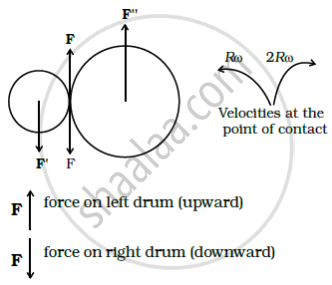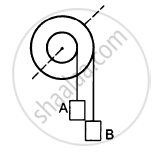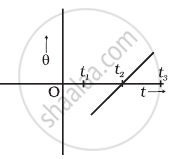Advertisements
Advertisements
प्रश्न
Two cylindrical hollow drums of radii R and 2R, and of a common height h, are rotating with angular velocities ω(anti-clockwise) and ω(clockwise), respectively. Their axes, fixed are parallel and in a horizontal plane separated by (3R + δ). They are now brought in contact (δ → 0).
- Show the frictional forces just after contact.
- Identify forces and torques external to the system just after contact.
- What would be the ratio of final angular velocities when friction ceases?
उत्तर
a. The frictional forces acting between two cylindrical hollow drums are shown in the diagram below.
Force F upward shows the friction force on the left drum.
Force F downward shows the friction force on the right drum.
b. F' = F = F” where F and F” are external forces through support.
⇒ Fnet = 0 ......(one each cylinder)
Net external torque to the system about any axis = F × 3R, anticlockwise

c. Let ω1 and ω2 be the final angular velocities of smaller and bigger drums respectively (anticlockwise and clockwise respectively).
Finally, there will be no friction. When friction ceases at the point of contact, then both drums have an equal linear velocity at that point.
VA = VB
Hence, Rω1 = 2Rω2 ⇒ `ω_1/ω_2` = 2
Important point: Friction force just opposes the relative motion of the point of contact at any instant. So, we should be very careful while indicating the direction of frictional forces.
APPEARS IN
संबंधित प्रश्न
A body is in pure rotation. The linear speed \[\nu\] of a particle, the distance r of the particle from the axis and the angular velocity \[\omega\] of the body are related as \[\omega = \frac{\nu}{r}.\] Thus
The following figure shows a small wheel fixed coaxially on a bigger one of double the radius. The system rotates about the common axis. The strings supporting A and B do not slip on the wheels. If x and y be the distance travelled by A and B in the same time interval, then _________ .

A sphere is rolled on a rough horizontal surface. If gradually slows down and stops. The force of friction tries to
(a) decrease the linear velocity
(b) increase the angular velocity
(c) increase the linear momentum
(d) decrease the angular velocity.
A disc of radius 10 cm is rotating about its axis at an angular speed of 20 rad/s. Find the linear speed of the middle point of a radius.
A wheel of mass 10 kg and radius 20 cm is rotating at an angular speed of 100 rev/min when the motor is turned off. Neglecting the friction at the axle, calculate the force that must be applied tangentially to the wheel to bring it to rest in 10 revolutions.
A cylinder rotating at an angular speed of 50 rev/s is brought in contact with an identical stationary cylinder. Because of the kinetic friction, torques act on the two cylinders accelerating the stationary one and decelerating the moving one. If the common magnitude of the acceleration and deceleration be one revolution per second square, how long will it take before the two cylinders have equal angular speed?
A dumb-bell consists of two identical small balls of mass 1/2 kg each connected to the two ends of a 50 cm long light rod. The dumb-bell is rotating about a fixed axis thorough the centre of the rod and perpendicular to it at an angular speed of 10 rad/s. An impulsive force of average magnitude 5⋅0 N acts on one of the masses in the direction of its velocity for 0⋅10 s. Find the new angular velocity of the system.
Suppose the platform of the previous problem is brought to rest with the ball in the hand of the kid standing on the rim. The kid throws the ball horizontally to his friend in a direction tangential to the rim with a speed \[\nu\] as seen by his friend. Find the angular velocity with which the platform will start rotating.
A ball falls on the ground from a height of 2.0 m and rebounds up to a height of 1.5 m. Find the coefficient of restitution.
The variation of angular position θ, of a point on a rotating rigid body, with time t is shown in figure. Is the body rotating clock-wise or anti-clockwise?

